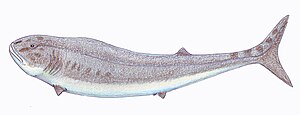Orodontidae
| Orodontidae | ||||||||||||
|---|---|---|---|---|---|---|---|---|---|---|---|---|

|
||||||||||||
| Temporal occurrence | ||||||||||||
| Pennsylvania (Upper Carboniferous) to Artinskian (Lower Permian) | ||||||||||||
| 312 to 279.5 million years | ||||||||||||
| Systematics | ||||||||||||
|
||||||||||||
| Scientific name of the order | ||||||||||||
| Orodontiformes | ||||||||||||
| Zangerl , 1981 | ||||||||||||
| Scientific name of the family | ||||||||||||
| Orodontidae | ||||||||||||
| de Koninck , 1878 |
The Orodontidae or Orodontida are an extinct group of shark-like cartilaginous fish whose fossil remains have been found in marine deposits of the Upper Paleozoic Era . The fish were elongated, had only very small fins, without fin spines, a single dorsal fin and no anal fin . Her teeth were blunt pinched teeth arranged in plate-like plasters, which had elongated crowns with ribbed surfaces.
With a body length of up to four meters, the Orodontida are among the largest Paleozoic cartilaginous fish.
literature
- Robert L. Carroll : Paleontology and Evolution of the Vertebrates , Thieme, Stuttgart (1993), ISBN 3-13-774401-6 .
- Joseph S. Nelson : Fishes of the World , John Wiley & Sons, 2006, ISBN 0-471-25031-7 .
Web links
- The Paleobiology Database Orodontida